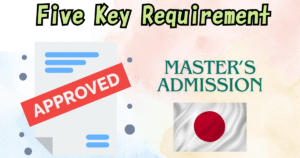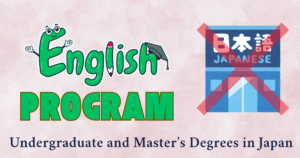Japan’s universities are sounding the alarm over a looming shortage of home‑grown researchers. Government white papers tied to the 6th Science and Technology Basic Plan warn that domestic PhD enrolment has fallen by almost 25% in a decade. In response, the plan places the cultivation and support of doctoral students at the core of Japan’s national science and technology policy, aiming to rebuild a strong research talent pipeline. To plug the talent gap, ministries now appeal to ambitious international students with streamlined visa rules and an increasing number of English‑medium doctoral tracks. If you aim for a doctoral seat in Japan, focus on the five key requirements below—especially Research Achievements & Capability and the University‑Specific Screening, which carry even greater weight at PhD level than they do for a master’s degree.
1. Formación académica
Most universities require applicants to have completed a master’s degree (or equivalent) in a relevant field, backed bya strong academic record and rigorous methodology training. In Japan, undergraduate and master’s GPAs are not given much weight. The University of Tokyo Graduate Admissions page, for example, specifies that doctoral entrants normally hold a master’s and study at least three years before thesis defence. Interdisciplinary or international master’s programmes are viewed favourably because they align with Japan’s push for global research collaboration.
Equivalency Pathways
If you do not hold a master’s but possess a strong research record, many faculties allow a “pre‑doctoral qualification exam” to certify master’s‑level ability. This route is common for industry professionals and MDs returning to academia. Refer to your target school’s shutsugan youkou (application guidelines) to confirm eligibility.
- Minimum GPA target: 3.0 / 4.0 or B+ average
- Methodology courses in statistics or lab techniques
- Capstone thesis or peer‑reviewed project report
2. Language Proficiency — Japanese or English
Although many doctoral programmes now teach core courses in English, day‑to‑day lab life—from safety briefings to reagent orders—often relies on Japanese. For Japanese‑medium tracks, aim for JLPT N2 or N1; English tracks usually ask for TOEFL iBT 80+ o IELTS 6.5+. Okayama University lists any one of JLPT N2, TOEFL 61 + or IELTS 6.0 + as the minimum for research students (admissions FAQ).
| Test | Typical Cut‑off |
|---|---|
| JLPT | N2 – N1 |
| TOEFL iBT | 80 – 100 |
| IELTS Academic | 6.5 – 7.0 |
Bilingual Lab Culture
Depending on the lab, some meetings may be bilingual—with materials in English and discussion in Japanese—so the ability to switch between languages is often helpful. Many universities also offer Japanese language classes for international students. If you want to navigate daily lab life more smoothly, start with the following small but effective habits
- Learn lab‑specific kanji (e.g., 試薬 = reagent, 遠心 = centrifuge)
- Practice senpai‑kohai etiquette phrases
- Join language‑exchange circles for daily immersion
3. Research Achievements & Capability ★Crítico
Publications & Conferences
At PhD level, you are expected to arrive not just with curiosity but a track record. Peer‑reviewed journal articles, Scopus‑indexed conference papers, datasets with DOIs(Digital Object Identifier) and patents all strengthen your application. Many faculties shortlist candidates by bibliometric impact before they even read the proposal.
Research Plan Quality
Your research plan must show originality, feasibility within three years and alignment with your prospective supervisor’s projects. The International University of Japan PhD guidelines state that evaluation hinges on whether the resulting dissertation could be accepted by a peer‑reviewed journal—a steeper bar than for master’s admissions.
Open Science & Collaboration
Japan’s funding agencies increasingly favour open‑data and cross‑sector projects. Uploading code to GitHub or datasets to the J‑STAGE Data Repository signals readiness for collaborative science.
- Pre‑register study protocols on OSF(Open Science Framework)
- Share data under Creative Commons licence
- Co‑author with Japanese labs before applying
4. University‑Specific Screening ★Crítico
Documents, Recommendations & Interview
After document screening, most faculties invite shortlisted PhD applicants to an online or in‑person interview. Expect probing questions on methodology, ethics and how your work fits Japan’s national research agenda. Letters of recommendation carry extra weight because they serve as proxies for your readiness to conduct independent research.
Interview Tips
Prepare a concise three‑minute “elevator pitch” in both English and, if possible, Japanese. Show familiarity with your interviewer’s recent papers. Many panels appreciate a brief slide deck summarising objectives, methods and expected impacts; confirm whether screen‑sharing is allowed in advance.
- Cite one Japanese journal that could publish your thesis
- Discuss potential industry partnerships (e.g., R&D consortia)
- Articulate a fallback plan if experiments fail
5. Preparación financiera o becas
Annual tuition at national universities hovers around JPY 535,800 (≈ USD 3,400), with private schools charging more. Living costs in Tokyo typically range from JPY 120,000 to 150,000 per month. The Beca MEXT waives tuition and provides a stipend of roughly JPY 145,000, while prefectural grants can add housing subsidies.
| Monthly Expense | Typical Cost (JPY) |
|---|---|
| Housing Costs | ¥50,000 to ¥80,000 |
| Health Insurance & Medical Costs | ¥2,000 to ¥10,000 |
| Groceries | ¥30,000 |
| Eating out | ¥10,000 |
| Other Essentials | ¥20,000 |
Key Scholarship Options
Apply at least a year ahead; many schemes close before university deadlines.
- Beca de Honor JASSO — monthly stipend, no tuition waiver
- ADB‑JSP — full tuition plus travel for students from member countries
- University‑Designated Assistantships — research salary tied to lab projects
Sound financial planning signals commitment—and some faculties informally factor it into final decisions.


